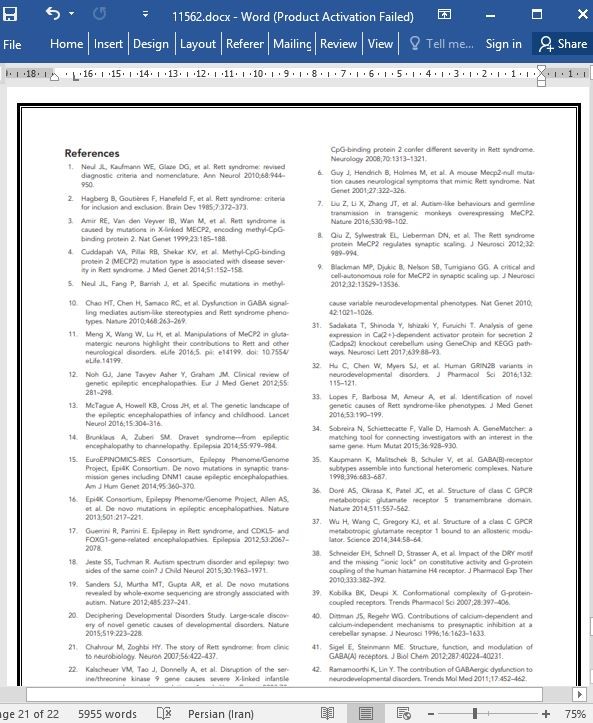
جهش های GABBR2 تعیین کننده فنوتیپ در سندرم رت و بیماری های مغزی صرعی
هدف: سندرم رت (RTT) و بیماری های مغزی صرعی(EE) از اختلالات مخرب رشد مغزی هستند که هر کدام دارای معیارهای تشخیصی مجزا هستند. به هر حال، ویژگی های بالینی همپوش و همگون دو بیماری معمولا بیماران را در مرز دو شرط قرار می دهند و نیازمند تشخیص دقیق و اقدامات پزشکی مناسب هستند. بنابراین، ما مکانیزم های ملکولی خاصی را بررسی کردیم که امکان درک پاتوژنی و رابطه این دو شرط را فراهم می آورد.
روش ها: ما فاکتورهای جدید ژنتیکی را در 34 بیمار مبتلا به RTT فاقد جهش MECP2 با استفاده از ترتیب گذاری اگزوم ها غربالگری کردیم که حدود90 درصد از مواردRTT را در بر می گیرند. عملکرد زیستی گونه های کشف شده در کشت سلولی و مدل های مدار زنوپوس ارزیابی شدند.
نتایج: ما یک گونه برگشتی در گیرنده GABAB ( R2) با عنوان(GABBR2) شناسایی کردیم که عملکرد گیرنده را کاهش می دهد، در حالیکه گونه های مختلف GABBR2 در بیماران EE تاثیر بیشتری در کاهش فعالیت گیرنده دارند و در برابر رهایی از اضطراب و کشش در مدل حیوانی واکنش پذیر تر بودند.
تفسیر: GABBR2 یک فاکتور ژنتیک است که تعیین کننده وجود فنوتیپ های شبهRTT یا EE با توجه به موقعیت گونه هستند. سیگنال دهی اسید سی – آمینوبوتریک در صورت وساطت GABBR2 یک عامل مهم در تعیین شدت و ماهیت فنوتیپ های رشد عصب می باشد.
بحث
وجود سیگنال های مناسب بازدارنده و محرک تعادلی دلالت بر شکل گیری طبیعی محل اتصال اعصاب و رشد نرمال مغز دارد. اختلال در GABA که یک سیگنال بازدارنده مهم است می تواند با چندین اختلال مغزی در ارتباط باشد. به علاوه، حتی کاهش متوسط ( حدود 30 تا 40 درصد ) در آزادسازی GABA منجر به اختلال رشد عصب در موش ها می شود و این مطلب در یک تحقیق انجام شده در مورد نرون های MECP2 و GABA تایید شده است. به هر حال، این مطلب که آیا این تغییر می تواند ویژگی های رشد مغزی در انسان ها و همچنین فنوتیپ ها را تحت تاثیر قرار دهد همچنان نامشخص است. در این تحقیق، شواهدی را در مورد وجود GABBR2 در تولید فنوتیپ های شبیه RTT ارائه کرده ایم و عملکرد آن در ارتباط با فنوتیپ EE بررسی کرده ایم. این تحقیق شواهد مستقیمی در انسان ارائه می کند که با توجه به آن بیان می شود که سیگنال های GABA تحت تاثیر GABABR منجر به RTT یا پاتوژنی صرع می شود و GABBR2 می تواند با توجه به شدت جهش ها این فنوتیپ ها را تحت تاثیر قرار دهد.
Abstract
Objective Rett syndrome (RTT) and epileptic encephalopathy (EE) are devastating neurodevelopmental disorders with distinct diagnostic criteria. However, highly heterogeneous and overlapping clinical features often allocate patients into the boundary of the two conditions, complicating accurate diagnosis and appropriate medical interventions. Therefore, we investigated the specific molecular mechanism that allows an understanding of the pathogenesis and relationship of these two conditions.
Methods We screened novel genetic factors from 34 RTT‐like patients without MECP2 mutations, which account for ∼90% of RTT cases, by whole‐exome sequencing. The biological function of the discovered variants was assessed in cell culture and Xenopus tropicalis models.
Results We identified a recurring de novo variant in GABAB receptor R2 (GABBR2) that reduces the receptor function, whereas different GABBR2 variants in EE patients possess a more profound effect in reducing receptor activity and are more responsive to agonist rescue in an animal model.
Interpretation GABBR2 is a genetic factor that determines RTT‐ or EE‐like phenotype expression depending on the variant positions. GABBR2‐mediated γ‐aminobutyric acid signaling is a crucial factor in determining the severity and nature of neurodevelopmental phenotypes.
Discussion
Fine-tuning the excitatory and inhibitory signaling balance ensures normal synapse formation and brain development. As a critical inhibitory signal, perturbations in GABA signaling have been associated with a range of brain disorders.42 Indeed, even a modest reduction (30–40%) in GABA release led to neurodevelopmental defects in mice, as evidenced by a study that specifically abolished MECP2 in GABAergic neurons.10 However, whether this alteration can compromise neurodevelopmental features in humans and its phenotypic consequences remained unknown. Here, we provided evidence of GABBR2A567T in the generation of an RTT-like phenotype and explored its function in relation to the EE phenotype. This study provides direct evidence in human that perturbed GABABR-mediated GABA signaling leads to RTT or epilepsy pathogenesis and GABBR2 can confer such variable phenotypes depending on the severity of the mutations.
شرکت کنندگان و روش ها
شرکت کنندگان
شناسایی و اعتبار سنجی گونه ها
وسترن بلات ( نمونه غربی)
ارزیابی ایمنوفلورسانس
ارزیابی رنگدانه
آزمایشات وزغ
تحلیل آماری
نتایج
جهش در GABBR2 باعث اختلال در عملکرد درست گیرنده ها می شود
اختلال GABBR2 در فنوتیپ های شبیهRTT و EE
بحث
Subjects and Methods
Subjects
Identification and Validating Variants
Western Blot
Immunofluorescence Assay
Luciferase Assay
Frog Experiments
Statistical Analysis
Results
A Recurrent De Novo Variant of GABBR2 Was Discovered in RTT-Like Patients
Mutations in GABBR2 Disrupt Proper Receptor Function
Perturbations of GABBR2 in Frog Phenocopy RTT- and EE-Like Phenotypes
Discussion
- اصل مقاله انگلیسی با فرمت ورد (word) با قابلیت ویرایش
- ترجمه فارسی مقاله با فرمت ورد (word) با قابلیت ویرایش، بدون آرم سایت ای ترجمه
- ترجمه فارسی مقاله با فرمت pdf، بدون آرم سایت ای ترجمه



